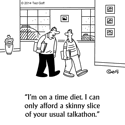Two things happened to me recently that got me thinking about online product forums.
In the first instance, I was looking for an inexpensive hotel in Las Vegas. Deals abounded, but complications arose when I looked into the customer comments published for each hotel. Here's an extreme example:
Room was not in the main tower, it was right by the parking lot and the tunnel you had to walk through to get to the room smelled like puke and urine, also very hot. The door to the room beside us looked like it was ajar so I gave a little push, on the bed was a naked man laying there. Looked like he was waiting for someone to come into the room. I quickly closed the door and retreated back to our room. A few minutes later I looked back out and the door was ajar again. I think he was for hire. Was very scared because there was an adjoining door. It was very late and were very tired so tried to get some sleep. NOT! So much noise. Twice that night someone tried to open our door. Very scary. Cockroaches in bathroom in morning. Also very squeeky bed springs in room above that continued sqeeking for a long time (must be Viagra) Funny coincidence the room number was 169. This hotel is the seediest most unsafe disgusting place I have ever had to stay in. Never ever would go back.
Needless to say, I stopped looking for the lowest-cost deals after reading stuff like this.
Soon thereafter, I was one of a number of folks who received the same email from a friend, who had just opened a new business in town. She felt that a user review in Yelp.com, which had some criticisms, needed to be countered. To my friend, the negative statements were damaging. To me, as someone who works with helping companies listen to customers, the feedback was valuable and could be useful to her.
These two examples underline that even if you're the Ritz-Carlton (never mind the hotel with the naked man on the bed), you will not get a perfect score from your clients. Not if they're being candid with you. They will point out things that bothered them, that didn't go perfectly, that are chronic weaknesses. Ignoring these forums or getting defensive is not only unwise, it's self-defeating.
I wrote to my friend who has opened the local business. I told her that the Yelp review, while not 100% positive, did say many positive things (among which was that the reviewer had visited several times and planned to go back again--a strong testament). The negative things were accurate and, happily, could be easily addressed.
I recommended to her rather than try to debate the reviewer, take her comments to heart, act on them, and invite her back for another look.
I don't know what to say to the owner of the hotel described above. Suffice it to say I won't be staying anywhere near it.





















